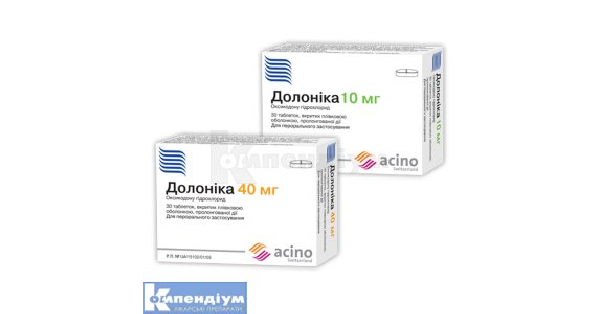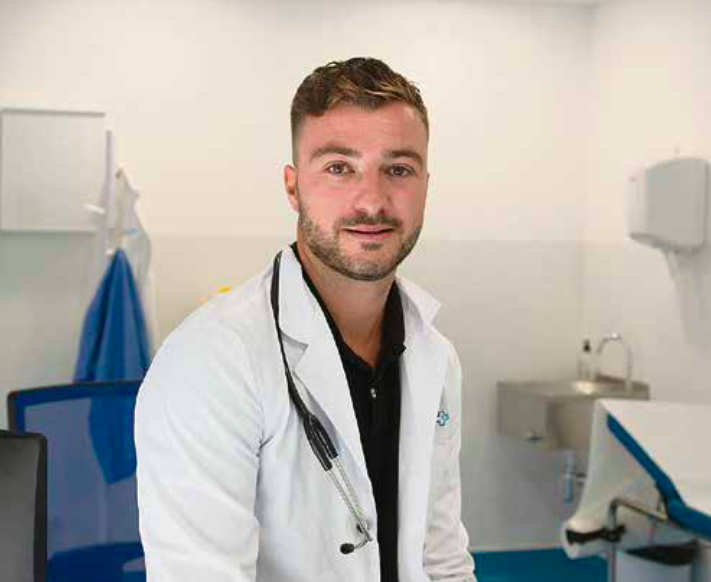

DOLONIKA 80 MG

Ask a doctor about a prescription for DOLONIKA 80 MG

How to use DOLONIKA 80 MG
INSTRUCTIONS FOR MEDICAL USE OF FEBUXOSTAT XANTIS
Composition
The active substance is febuxostat; 1 film-coated tablet contains febuxostat 80 mg or 120 mg; excipients: lactose monohydrate, sodium croscarmellose, microcrystalline cellulose, hydroxypropylcellulose, colloidal silicon dioxide, magnesium stearate, light magnesium oxide, partially hydrolyzed polyvinyl alcohol, titanium dioxide (E 171), macrogol, talc, yellow iron oxide (E 172).
Pharmaceutical form
Tablets, film-coated.
Main physical and chemical properties
Capsule-shaped, film-coated tablets, from pale yellow to yellow in color, with engraving "80" or "120" on one side.
Pharmacotherapeutic group
Medicines for the treatment of gout. Medicines that inhibit the formation of uric acid. ATC code M04AA03.
Pharmacological properties
Pharmacodynamics
Mechanism of action
Uric acid is the final product of purine metabolism in humans and is formed during such a reaction: hypoxanthine → xanthine → uric acid. Xanthine oxidase is the catalyst for both stages of this reaction. Febuxostat is a derivative of 2-arylthiazole, its therapeutic effect is associated with a decrease in serum uric acid concentration by selectively inhibiting xanthine oxidase. Febuxostat is a potent and selective non-purine inhibitor of xanthine oxidase (NP-SIXO), its Ki (inhibition constant) in vitro is less than 1 nanomole. It has been shown that febuxostat significantly inhibits the activity of both oxidized and reduced forms of xanthine oxidase. At therapeutic concentrations, febuxostat does not inhibit other enzymes involved in purine or pyrimidine metabolism, such as guanase, hypoxanthine-guanine phosphoribosyltransferase, orotate phosphoribosyltransferase, orotidine monophosphate decarboxylase, or purine nucleoside phosphorylase.
Clinical efficacy and safety
Gout
The efficacy of febuxostat was confirmed in phase 3 of three main studies (two main studies APEX and FACT and additional study CONFIRMS, described below), which included 4101 patients with hyperuricemia and gout. In each of these main studies, febuxostat was more effective in reducing serum uric acid concentration and maintaining it at a proper level compared to allopurinol. The primary endpoint of efficacy in the APEX and FACT studies was the proportion of patients whose serum uric acid concentration did not exceed 6.0 mg/dL (357 μmol/L) during the last three months. In the additional phase 3 study CONFIRMS, the primary endpoint of efficacy was the proportion of patients whose serum uric acid concentration did not exceed 6.0 mg/dL at the last visit. These studies did not include patients who had undergone organ transplantation (see "Special instructions").
APEX study
The APEX study was a randomized, double-blind, placebo-controlled efficacy study of febuxostat, phase 3 (Allopurinol and Placebo-Controlled Efficacy Study of Febuxostat, APEX), which was a randomized, double-blind, multicenter study lasting 28 weeks. A total of 1072 patients were randomized: placebo (n = 134), febuxostat 80 mg once daily (n = 267), febuxostat 120 mg once daily (n = 269), febuxostat 240 mg once daily (n = 134) or allopurinol (300 mg once daily (n = 258) for patients with baseline serum creatinine ≤ 1.5 mg/dL or 100 mg once daily (n = 10) for patients with baseline serum creatinine > 1.5 mg/dL and ≤ 2.0 mg/dL). For safety assessment, febuxostat was administered at a dose of 240 mg (twice the maximum recommended dose).
APEX study showed a statistically significant advantage of both febuxostat 80 mg once daily and febuxostat 120 mg once daily compared to allopurinol at a usual dose of 300 mg (n = 258) / 100 mg (n = 10) in reducing serum uric acid concentration below 6 mg/dL (357 μmol/L) (see Table 1 and Figure 1).
FACT study
The FACT study was a randomized, allopurinol-controlled trial of febuxostat, phase 3 (The Febuxostat Allopurinol Controlled Trial, FACT), which was a randomized, double-blind, multicenter study lasting 52 weeks. A total of 760 patients were randomized: febuxostat 80 mg once daily (n = 256), febuxostat 120 mg once daily (n = 251), and allopurinol 300 mg once daily (n = 253).
FACT study showed a statistically significant advantage of both febuxostat 80 mg once daily and febuxostat 120 mg once daily compared to allopurinol at a usual dose of 300 mg in reducing and maintaining serum uric acid concentration below 6 mg/dL (357 μmol/L).
Table 1 presents the results of the primary efficacy endpoint assessment.
Table 1. Proportion of patients with serum uric acid concentration < 6.0 mg/dL (357 μmol/L) during the last three monthly visits
| Study | Febuxostat 80 mg once daily | Febuxostat 120 mg once daily | Allopurinol 300/100 mg once daily |
| APEX (28 weeks) | 48 %*(n = 262) | 65 %*, #(n = 269) | 22 %(n = 268) |
| FACT (52 weeks) | 53 %*(n = 255) | 62 %*(n = 250) | 21 %(n = 251) |
| Combined results | 51 %*(n = 517) | 63 %*, #(n = 519) | 22 %(n = 519) |
| 1Results in patients who received 100 mg once daily (n = 10: patients with baseline serum creatinine > 1.5 mg/dL and ≤ 2.0 mg/dL) or 300 mg once daily (n = 509), in the analysis were combined.* p < 0.001 compared to allopurinol.#p < 0.001 compared to 80 mg dose. | |||
When using febuxostat, the reduction in serum uric acid concentration was rapid and long-lasting. A decrease in serum uric acid concentration to < 6.0 mg/dL (357 μmol/L) was observed as early as the second week of the study and persisted during treatment. Figure 1 shows the mean serum uric acid concentrations over time for each therapeutic group in both phase 3 studies.
Figure 1. Mean serum uric acid concentrations from combined pivotal studies (phase 3)
Note: 509 patients received allopurinol at a dose of 300 mg once daily; 10 patients with serum creatinine > 1.5 mg/dL and < 2.0 mg/dL received allopurinol at a dose of 100 mg once daily (10 out of 268 patients in the APEX study). Febuxostat at a dose of 240 mg was administered for safety assessment at a dose twice the maximum recommended.
CONFIRMS study
The CONFIRMS study was a randomized, controlled study of phase 3, lasting 26 weeks, which was conducted to evaluate the safety and efficacy of febuxostat at doses of 40 mg and 80 mg compared to allopurinol at doses of 300 mg and 200 mg for patients with gout and hyperuricemia. A total of 2269 patients were randomized: febuxostat 40 mg once daily (n = 757), febuxostat 80 mg once daily (n = 756), and allopurinol 300/200 mg once daily (n = 756). At least 65% of patients had renal impairment from mild to moderate (with creatinine clearance 30–89 mL/min). Prevention of gout attacks was mandatory during 26 weeks.
The proportion of patients with serum uric acid concentration < 6.0 mg/dL (357 μmol/L) at the last visit was 45% in the group receiving febuxostat 40 mg, 67% in the group receiving febuxostat 80 mg, and 42% in the group receiving allopurinol 300/200 mg, respectively.
Primary endpoint in the subgroup of patients with renal impairment
In the APEX study, the efficacy of the drug was evaluated in 40 patients with renal impairment (i.e., with baseline serum creatinine > 1.5 mg/dL and ≤ 2.0 mg/dL). Such patients, randomized to the allopurinol group, had their dose reduced to 100 mg once daily. The primary endpoint of efficacy was achieved in the febuxostat groups in 44% of patients (80 mg once daily), 45% (120 mg once daily), and 60% (240 mg once daily) compared to 0% in the allopurinol 100 mg once daily and placebo groups.
Meanwhile, clinically significant differences in the reduction of serum uric acid concentration as a percentage were not observed in healthy volunteers, regardless of renal function (58% in the group with normal renal function and 55% in the group with severe renal impairment).
Prospective analysis conducted in patients with gout and renal impairment using the CONFIRMS study showed that febuxostat was significantly more effective: serum uric acid level decreased to a level < 6.0 mg/dL compared to allopurinol 300 mg/200 mg in patients with gout and renal impairment from mild to moderate (65% of patients).
Primary endpoint in the subgroup of patients with serum uric acid concentration ≥ 10 mg/dL
Baseline serum uric acid concentration ≥ 10 mg/dL was observed in approximately 40% of patients (combined APEX and FACT studies). Among these patients, the primary efficacy endpoint (serum uric acid concentration < 6.0 mg/dL in the last three visits) was achieved in the febuxostat subgroups in 41% of patients (80 mg once daily), in 48% of patients (120 mg once daily), and in 66% of patients (240 mg once daily) compared to 9% in the allopurinol 300 mg/100 mg once daily group and 0% in the placebo group.
According to the CONFIRMS study, the proportion of patients who achieved the primary efficacy endpoint (serum uric acid concentration < 6.0 mg/dL at the last visit) in the subgroup of patients with baseline serum uric acid concentration ≥ 10 mg/dL, who received febuxostat 40 mg once daily, was 27% (66/249), febuxostat 80 mg once daily — 49% (125/254), and allopurinol 300 mg/200 mg once daily — 31% (72/230).
Clinical outcomes: percentage of patients requiring gout flare therapy
In the APEX study, during the 8-week prophylactic period, patients in the febuxostat 120 mg group (36%) who required gout flare therapy were compared to patients who received febuxostat 80 mg (28%), allopurinol 300 mg (23%), and placebo (20%). The frequency of flares was higher after the prophylactic period and gradually decreased over time. From 46% to 55% of patients underwent gout flare therapy from week 8 and week 28. Gout flares that occurred during the last 4 weeks of the study (24–28 weeks) were observed in 15% of patients in the febuxostat 80 mg and 120 mg groups, 14% of patients in the allopurinol 300 mg group, and 20% of patients in the placebo group.
In the FACT study, during the 8-week prophylactic period, patients in the febuxostat 120 mg group (36%) who required gout flare therapy were compared to patients in both therapeutic groups who received febuxostat 80 mg (22%) and allopurinol 300 mg (21%). After the 8-week prophylactic period, the frequency of flares increased and gradually decreased over time (64% and 70% of patients who received gout flare therapy from week 8 to week 52). Gout flares during the last 4 weeks of the study (49–52 weeks) were observed in 6–8% of patients in the febuxostat 80 mg and 120 mg groups and in 11% of patients in the allopurinol 300 mg group.
The proportion of patients who required treatment for gout flares (APEX and FACT studies) was lower in groups where the mean serum uric acid concentration after treatment decreased to < 6.0 mg/dL, < 5.0 mg/dL, or < 4.0 mg/dL, compared to groups where the mean uric acid level was ≥ 6.0 mg/dL in the last 32 weeks of treatment (from week 20–24 to week 49–52).
DURING THE CONFIRMS STUDY, THE PROPORTION OF PATIENTS WHO REQUIRED TREATMENT FOR GOUT FLARES (1 DAY EVERY 6 MONTHS) WAS 31% AND 25% IN THE GROUPS RECEIVING FEBUXOSTAT 80 MG AND ALLOPURINOL, RESPECTIVELY. NO DIFFERENCES WERE OBSERVED IN THE RATIO OF PATIENTS WHO REQUIRED TREATMENT FOR GOUT FLARES BETWEEN THE GROUPS RECEIVING FEBUXOSTAT 80 MG AND 40 MG.
Long-term open-label extension studies
The EXCEL study (C02-021) was a three-year, open-label, multicenter, randomized, allopurinol-controlled phase 3 study of safety, which was conducted to evaluate the safety of febuxostat in patients who had completed the main phase 3 studies (APEX or FACT). A total of 1086 patients were included in the study: febuxostat 80 mg once daily (n = 649), febuxostat 120 mg once daily (n = 292), and allopurinol 300/100 mg once daily (n = 145). Approximately 69% of patients did not require therapy adjustment to achieve the final stable treatment. Patients whose serum uric acid levels were > 6.0 mg/dL at three consecutive measurements were excluded from the study.
Serum uric acid levels did not change over time (in 91% and 93% of patients who initially received febuxostat at doses of 80 mg and 120 mg, respectively, serum uric acid levels were < 6.0 mg/dL at 36 months).
According to the three-year observation, in less than 4% of patients who required treatment, a decrease in the frequency of gout flares was observed at 16–24 months and 30–36 months (i.e., in more than 96% of patients, the need for gout flare treatment was absent).
In 46% and 38% of patients who received final stable treatment with febuxostat at a dose of 80 mg or 120 mg once daily, respectively, complete disappearance of primary palpable tophus was observed from the beginning to the last visit.
FOCUS study (TMX-01-005)
The FOCUS study (TMX-01-005) was a five-year, open-label, multicenter, extension safety study of phase 2, which was conducted in patients who had completed a 4-week course of febuxostat with double-blind dosing in the TMX-00-004 study. The study included 116 patients who initially received febuxostat 80 mg once daily. For 62% of patients, dose adjustment was not required to maintain a serum uric acid level of less than 6.0 mg/dL, and 38% of patients required dose adjustment to achieve the final stable concentration.
The proportion of patients with a serum uric acid level of less than 6.0 mg/dL (357 μmol/L) at the last visit was more than 80% (81–100%) in each of the febuxostat groups.
Post-marketing long-term studies
CARES study
The CARES study was a multicenter, randomized, double-blind, non-inferiority study in which the outcomes of cardiovascular events were compared when using febuxostat and allopurinol in patients with gout and a history of major cardiovascular events, including myocardial infarction, hospitalization for unstable angina, coronary or cerebral revascularization procedures, stroke, hospitalization for transient ischemic attack, peripheral vascular disease, or diabetes with signs of microangiopathy or macroangiopathy.
To achieve a plasma uric acid level of less than 6 mg/dL, the dose of febuxostat was titrated from 40 mg to 80 mg (regardless of renal function), and the dose of allopurinol was titrated with a step of 100 mg from 300 to 600 mg for patients with normal renal function and mild renal impairment, and from 200 to 400 mg for patients with moderate renal impairment.
The primary endpoint of the CARES study was the time to the first occurrence of MACE (major adverse cardiovascular events), consisting of non-fatal myocardial infarction, non-fatal stroke, death from cardiovascular causes, and unstable angina with urgent coronary revascularization.
The endpoints (primary and secondary) were analyzed according to the intention-to-treat (ITT) analysis, including all subjects who were randomized and received at least one dose of the study drug during the double-blind study.
In total, 56.6% of patients discontinued the study prematurely, and 45% of patients did not complete all study visits.
In total, 6190 patients were under observation for 32 months, with a mean exposure duration of 728 days for patients in the febuxostat group (n = 3098) and 719 days for patients in the allopurinol group (n = 3092).
The primary endpoint of MACE was observed with similar rates in the febuxostat and allopurinol treatment groups (10.8% vs. 10.4% of patients, respectively; hazard ratio [HR] 1.03; two-sided repeated 95% confidence interval [CI] 0.89–1.21).
When analyzing individual components of MACE, the frequency of cardiovascular mortality was higher in the febuxostat group than in the allopurinol group (4.3% vs. 3.2% of patients; hazard ratio 1.34; 95% CI 1.03–1.73). The frequency of other MACE events was similar in the febuxostat and allopurinol groups, namely: non-fatal myocardial infarction (3.6% vs. 3.8% of patients; hazard ratio 0.93; 95% CI 0.72–1.21), non-fatal stroke (2.3% vs. 2.3% of patients; hazard ratio 1.01; 95% CI 0.73–1.41), and urgent revascularization due to unstable angina (1.6% vs. 1.8% of patients; hazard ratio 0.86; 95% CI 0.59–1.26).
The frequency of mortality from all causes was also higher in the febuxostat group than in the allopurinol group (7.8% vs. 6.4% of patients; hazard ratio 1.22; 95% CI 1.01–1.47), which was mainly due to a higher level of cardiovascular mortality in this group (see "Special instructions").
The rates of hospitalization for heart failure, hospitalization for arrhythmia not related to ischemia, venous thromboembolic events, and hospitalization for transient ischemic attacks were comparable for febuxostat and allopurinol.
FAST study
The FAST study was a prospective, randomized, open-label study with blinded endpoint, which compared the cardiovascular safety profile of febuxostat and allopurinol in patients with chronic hyperuricemia (when urate deposition has already occurred) and risk factors for cardiovascular disease (i.e., patients aged 60 years and at least one other risk factor for cardiovascular disease).
Patients who met the inclusion criteria received allopurinol before randomization, and if necessary, their dose was adjusted based on clinical assessment, European League Against Rheumatism (EULAR) recommendations, and the approved dosing regimen. At the end of the allopurinol run-in period, patients with a serum uric acid (sUA) level of < 0.36 mmol/L (< 6 mg/dL) or patients who received the maximum tolerated dose or the maximum approved dose of allopurinol were randomized in a 1:1 ratio to receive either febuxostat or allopurinol. The primary endpoint of the FAST study was the time to the first occurrence of any event that is part of the Antiplatelet Trialists' Collaborative (APTC) endpoint, including:
- hospitalization for non-fatal myocardial infarction (MI)/acute coronary syndrome (ACS) with a positive biomarker response;
- non-fatal stroke;
- death from cardiovascular causes.
The primary analysis was based on the treatment-received approach.
In total, 6128 patients were randomized, of whom 3063 received febuxostat and 3065 received allopurinol.
In the primary analysis of patients who received treatment, febuxostat was not inferior to allopurinol in terms of the frequency of the primary endpoint, which was observed in 172 patients (1.72/100 patient-years) in the febuxostat group compared to 241 patients (2.05/100 patient-years) in the allopurinol group, with an adjusted hazard ratio [HR] of 0.85 (95% CI: 0.70, 1.03), p < 0.001. The analysis of data from patients who received treatment for the primary endpoint in the subgroup of patients with a history of MI, stroke, or ACS did not show a significant difference between the treatment groups: 65 (9.5%) patients with events in the febuxostat group and 83 (11.8%) patients with events in the allopurinol group; adjusted hazard ratio [HR] 1.02 (95% CI: 0.74–1.42); p = 0.202.
Treatment with febuxostat was not associated with an increased risk of cardiovascular mortality or mortality from other causes, either overall or in the subgroup of patients with a history of MI, stroke, or ACS. In general, there were fewer deaths in the febuxostat group (62 cardiovascular deaths and 108 deaths from other causes) than in the allopurinol group (82 cardiovascular deaths and 174 deaths from other causes).
When treated with febuxostat, a greater reduction in uric acid levels was observed compared to treatment with allopurinol.
Tumor lysis syndrome (TLS)
The efficacy and safety of febuxostat for the prevention and treatment of TLS were evaluated in the FLORENCE study (FLO-01). Febuxostat demonstrated better and faster action in reducing urate levels compared to allopurinol.
FLORENCE was a randomized (1:1), double-blind, controlled study of phase 3, in which the use of febuxostat at a dose of 120 mg once daily and allopurinol at a dose of 200–600 mg daily (mean daily dose of allopurinol [± standard deviation]: 349.7 ± 112.90 mg) was compared under control of serum uric acid concentration. Selected patients were required to be candidates for allopurinol treatment or not have access to rasburicase. The primary endpoints were the area under the serum uric acid concentration curve (AUC sUA1–8) and the change in serum creatinine (sCr) from day 1 to day 8.
A total of 346 patients with hematological malignancies who were receiving chemotherapy and had a moderate or high risk of developing TLS were included in the study. The mean AUC sUA1–8 (mg × h/dL) was significantly lower with febuxostat (514.0 ± 225.71 compared to 708.0 ± 234.42; least squares mean for difference: –196.794 [95% confidence interval: –238.600; –154.988]; p < 0.0001). Additionally, the mean serum uric acid concentration was significantly lower with febuxostat, starting from the first 24 hours of treatment and at any subsequent time point. Statistically significant differences in mean serum creatinine (%) between febuxostat and allopurinol were not observed (–0.83 ± 26.98 compared to –4.92 ± 16.70, respectively; least squares mean for difference: 4.0970 [95% confidence interval: –0.6467; 8.8406]; p = 0.0903). Considering the secondary endpoints, statistically significant differences in the frequency of laboratory-confirmed TLS were not observed (8.1% and 9.2% in the febuxostat and allopurinol groups, respectively; relative risk: 0.875 [95% confidence interval: 0.4408; 1.7369]; p = 0.8488) and clinical TLS syndrome (1.7% and 1.2% for febuxostat and allopurinol, respectively; relative risk: 0.994 [95% confidence interval: 0.9691; 1.0199]; p = 1.0000). The frequency of all signs and symptoms that occurred during treatment, as well as adverse reactions, was 67.6% compared to 64.7% and 6.4% compared to 6.4% in the febuxostat and allopurinol groups, respectively. In the FLORENCE study, febuxostat demonstrated better and faster action in reducing serum uric acid levels compared to allopurinol. Data on the comparison of febuxostat and rasburicase are not available at this time. The efficacy and safety of febuxostat have not been established for patients with acute severe TLS, such as patients for whom other types of urate-lowering therapy are ineffective.
Pharmacokinetics
In healthy volunteers, the maximum plasma concentration (Cmax) and area under the curve (AUC) of febuxostat increased proportionally with the dose after single and multiple administration of febuxostat at doses ranging from 10 mg to 120 mg. At doses ranging from 120 mg to 300 mg, the increase in AUC was greater than proportional to the dose. With doses of 10–240 mg every 24 hours, no accumulation of febuxostat was observed. The predicted mean terminal half-life (t1/2) of febuxostat was approximately 5–8 hours. A population pharmacokinetic/pharmacodynamic analysis was conducted using data from 211 patients with hyperuricemia and gout who received febuxostat at doses of 40–240 mg once daily. Overall, the pharmacokinetic parameter values obtained were similar to those in healthy volunteers, which are therefore a good model for evaluating the pharmacokinetics/pharmacodynamics of the drug in patients with gout.
Absorption
Febuxostat is rapidly (tmax [time to reach maximum concentration] 1.0–1.5 hours) and well absorbed (at least 84%). After single and multiple oral administration of febuxostat at doses of 80 mg or 120 mg once daily, Cmax was 2.8–3.2 μg/mL and 5.0–5.3 μg/mL, respectively. The absolute bioavailability of febuxostat tablets has not been analyzed. When febuxostat was administered with a high-fat meal, Cmax decreased by 49% and 38%, and AUC decreased by 18% and 16%, respectively. However, this was not associated with clinically significant changes in the degree of reduction in serum uric acid concentration (with multiple administration at a dose of 80 mg). Therefore, febuxostat can be taken without regard to food.
Distribution
The predicted volume of distribution at steady state (Vss/F) of febuxostat ranges from 29 to 75 L after oral administration at a dose of 10–300 mg. The degree of binding of febuxostat to plasma proteins (mainly albumin) is 99.2% and does not change with increasing doses from 80 mg to 120 mg. For active metabolites of febuxostat, the degree of binding to plasma proteins ranges from 82 to 91%.
Metabolism
Febuxostat is actively metabolized by conjugation involving uridine diphosphate glucuronosyltransferase (UDP-glucuronosyltransferase) and oxidation involving cytochrome P450 (CYP) enzymes. A total of four pharmacologically active hydroxy metabolites of febuxostat have been identified; three of them were detected in human plasma. In vitro studies using human liver microsomes have shown that these oxidized metabolites are formed primarily by CYP1A1, CYP1A2, CYP2C8, or CYP2C9, while febuxostat glucuronide is formed mainly by UDP-glucuronosyltransferase 1A1, 1A8, and 1A9.
Excretion
Febuxostat is excreted by the liver and kidneys. After oral administration of 14C-febuxostat at a dose of 80 mg, approximately 49% was excreted in the urine as unchanged febuxostat (3%), acyl glucuronide of the active substance (30%), known oxidized metabolites and their conjugates (13%), and other unknown metabolites (3%). In addition to renal excretion, approximately 45% of the dose was excreted in the feces as unchanged febuxostat (12%), acyl glucuronide of the active substance (1%), known oxidized metabolites and their conjugates (25%), and other unknown metabolites (7%).
Renal impairment
With multiple administration of febuxostat at a dose of 80 mg, no changes in Cmax of febuxostat were observed in patients with mild, moderate, or severe renal impairment compared to patients with normal renal function. The mean total AUC of febuxostat increased approximately 1.8-fold: from 7.5 μg × hour/mL in patients with normal renal function to 13.2 μg × hour/mL in patients with severe renal impairment. Cmax and AUC of active metabolites increased 2- and 4-fold, respectively. However, patients with renal impairment of mild or moderate severity do not require dose adjustment.
Hepatic impairment
With multiple administration of febuxostat at a dose of 80 mg, no significant changes in Cmax and AUC of febuxostat and its metabolites were observed in patients with mild (Child-Pugh class A) and moderate (Child-Pugh class B) hepatic impairment compared to patients with normal liver function. The study of the drug in patients with severe hepatic impairment (Child-Pugh class C) has not been conducted.
Age
With multiple oral administration of febuxostat, no significant changes in AUC of febuxostat and its metabolites were observed in elderly patients compared to young healthy volunteers.
Sex
With multiple oral administration of febuxostat, Cmax and AUC of febuxostat in women were 24% and 12% higher, respectively, than in men. However, Cmax and AUC adjusted for body weight were similar in both groups, so dose adjustment of febuxostat based on sex is not required.
Clinical characteristics
Indications
Febuxostat Xantis 80 mg and Febuxostat Xantis 120 mg
Indicated for the treatment of chronic hyperuricemia in diseases accompanied by urate deposition, including the presence of tophi and/or gouty arthritis, currently or in history.
Febuxostat Xantis 120 mg
Indicated for the treatment and prevention of hyperuricemia in adult patients undergoing chemotherapy for hematological malignancies with a moderate or high risk of tumor lysis syndrome (TLS).
Febuxostat Xantis is indicated for adult patients.
Contraindications
Hypersensitivity to the active substance or to any other excipient of the drug, as listed in the "Composition" section.
Interactions with other medicinal products and other forms of interaction
Mercaptopurine/azathioprine
According to its mechanism of action, febuxostat inhibits xanthine oxidase, so concomitant use is not recommended. Inhibition of xanthine oxidase may lead to increased concentrations of both drugs in plasma, which can cause a myelotoxic reaction. When co-administered with febuxostat, the dose of mercaptopurine/azathioprine should be reduced to 20% or less of the previously prescribed dose (see "Special instructions").
The adequacy of the proposed dose adjustment, which was based on modeling and simulation analysis of preclinical data in rats, was confirmed by the results of a clinical study of drug interaction in healthy volunteers who received azathioprine at a dose of 100 mg alone and a reduced dose of azathioprine (25 mg) in combination with febuxostat (40 or 120 mg).
Studies of febuxostat interaction during other cytotoxic chemotherapy have not been conducted. In the pivotal TLS study, patients with several chemotherapy regimens were administered febuxostat at a dose of 120 mg, including monoclonal antibodies. However, during this study, drug-drug interactions and drug-disease interactions were not investigated. Therefore, the possibility of interaction with any cytotoxic drugs that are concomitantly prescribed cannot be ruled out.
Rosiglitazone/CYP2C8 substrates
Febuxostat is a weak inhibitor of CYP2C8 in vitro. In a study in healthy volunteers, concomitant administration of 120 mg of febuxostat once daily and a single oral dose of rosiglitazone 4 mg did not affect the pharmacokinetics of rosiglitazone and its metabolite N-desmethylrosiglitazone, demonstrating that febuxostat does not inhibit the CYP2C8 enzyme in vivo. Therefore, concomitant administration of febuxostat and rosiglitazone or other CYP2C8 substrates does not require dose adjustment.
Theophylline
A study of febuxostat interaction was conducted in healthy volunteers to evaluate the effect of xanthine oxidase inhibition on the increased theophylline levels in the bloodstream, which was observed with other xanthine oxidase inhibitors. The results of the study showed that concomitant administration of febuxostat at a dose of 80 mg and theophylline at a dose of 400 mg did not result in any pharmacokinetic interactions or effects on theophylline safety. Therefore, febuxostat at a dose of 80 mg can be administered concomitantly with theophylline without special precautions. Data on the dose of febuxostat 120 mg are not available.
Naproxen and other glucuronidation inhibitors
The metabolism of febuxostat depends on the activity of the UDP-glucuronosyltransferase enzyme. Drugs that inhibit glucuronidation, such as nonsteroidal anti-inflammatory drugs (NSAIDs) and probenecid, may theoretically affect the elimination of febuxostat. In healthy volunteers, concomitant administration of febuxostat and naproxen 250 mg twice daily resulted in enhanced febuxostat activity (Cmax increased by 28%, AUC by 41%, and t1/2 by 26%). In clinical studies, concomitant use of naproxen and other NSAIDs/Cox-2 inhibitors was not associated with a clinically significant increase in adverse reactions.
Febuxostat can be administered concomitantly with naproxen without changing their doses.
Glucuronidation inducers
Potent inducers of the UDP-glucuronosyltransferase enzyme may enhance the metabolism and reduce the efficacy of febuxostat. In patients who are taking potent glucuronidation inducers, it is recommended to monitor the uric acid level in plasma within 1–2 weeks of concomitant therapy. When the inducer is discontinued, an increase in febuxostat plasma levels is possible.
Colchicine/indomethacin/hydrochlorothiazide/warfarin
Febuxostat can be administered concomitantly with colchicine or indomethacin without changing the dose of these drugs.
It is also not necessary to change the dose of febuxostat when administered concomitantly with hydrochlorothiazide.
Concomitant administration of febuxostat with warfarin does not require dose adjustment of the latter. The use of febuxostat (80 mg or 120 mg once daily) with warfarin in healthy volunteers did not affect the pharmacokinetics of the latter. Concomitant administration with febuxostat also did not affect the international normalized ratio (INR) and factor VII activity.
Desipramine/CYP2D6 substrates
Based on in vitro data, febuxostat is a weak inhibitor of CYP2D6. In a study in healthy volunteers who received 120 mg of febuxostat once daily, an increase in AUC of desipramine (a CYP2D6 substrate) by 22% was observed, indicating a weak inhibitory effect of febuxostat on the CYP2D6 enzyme in vivo.
Therefore, when febuxostat is administered concomitantly with CYP2D6 substrates, there is no need to adjust their doses.
Antacids
When febuxostat was administered concomitantly with antacids containing magnesium hydroxide and aluminum hydroxide, a delay in febuxostat absorption (by approximately 1 hour) and a decrease in Cmax by 32% were observed, although the AUC of febuxostat did not change significantly. Therefore, febuxostat can be administered with antacid drugs.
Special instructions
Cardiovascular diseases
During the development of the drug and in one post-marketing study (CARES), an increased number of cardiovascular events with fatal outcomes was observed in patients with existing major cardiovascular diseases (e.g., myocardial infarction, stroke, or unstable angina) when using febuxostat compared to allopurinol.
However, in a subsequent post-marketing study (FAST), febuxostat was not inferior to allopurinol in terms of the frequency of both fatal and non-fatal cardiovascular events.
Treatment of this group of patients should be carried out with caution and under regular supervision.
For more information on the safety of febuxostat for the cardiovascular system, see the "Adverse reactions" and "Pharmacodynamics" sections.
Prevention and treatment of hyperuricemia in patients at risk of tumor lysis syndrome (TLS)
Patients who are undergoing chemotherapy for hematological malignancies with a moderate or high risk of TLS and are taking febuxostat may require cardiology monitoring if clinically indicated.
Allergy/hypersensitivity to drugs
In the post-marketing surveillance, there were rare reports of serious allergic reactions/hypersensitivity reactions, including life-threatening Stevens-Johnson syndrome, toxic epidermal necrolysis, and acute anaphylactic reactions/shock. In most cases, such reactions occurred within the first month of febuxostat use. In several patients, renal function impairment and/or hypersensitivity to allopurinol were observed in history. Severe hypersensitivity reactions, including drug reaction with eosinophilia and systemic symptoms (DRESS syndrome), were in some cases associated with fever, hematologic, renal, or hepatic insufficiency.
Patients should be informed about the signs and symptoms of hypersensitivity/allergy and should be monitored for the development of such reactions. If serious allergic reactions/hypersensitivity reactions, including Stevens-Johnson syndrome, occur, the use of febuxostat should be discontinued immediately, as early discontinuation of the drug improves the prognosis. If a patient has experienced an allergic reaction/hypersensitivity reaction, including Stevens-Johnson syndrome, or acute anaphylactic reactions/shock, re-administration of febuxostat is contraindicated.
Gout flare (attack)
Treatment with febuxostat should only be started during the period after the exacerbation of the disease. Febuxostat may provoke a gout attack at the beginning of treatment due to changes in uric acid levels in the serum through the release of urates from deposits. At the start of febuxostat treatment, it is recommended to prescribe nonsteroidal anti-inflammatory drugs (NSAIDs) or colchicine for at least 6 months to prevent gout attacks.
If a gout attack occurs during febuxostat treatment, treatment should be continued. At the same time, appropriate individual therapy for the exacerbation of gout should be carried out. With prolonged use of febuxostat, the frequency and severity of gout attacks decrease.
Urate deposition
In patients with accelerated urate formation (e.g., in the context of malignancies and their treatment or in Lesch-Nyhan syndrome), a significant increase in the absolute concentration of urates in the urine is possible, which in rare cases may be accompanied by their deposition in the urinary tract. This was not observed in the pivotal clinical study of febuxostat in TLS. Due to limited experience with the use of febuxostat, the drug is not indicated for patients with Lesch-Nyhan syndrome.
Mercaptopurine/azathioprine
Febuxostat is not recommended for patients who are concomitantly receiving mercaptopurine/azathioprine, as inhibition of xanthine oxidase by febuxostat may lead to increased concentrations of mercaptopurine/azathioprine in plasma, which can cause severe toxicity.
If combinations are unavoidable, it is recommended to reduce the dose of mercaptopurine/azathioprine to 20% or less of the previously prescribed dose (see "Interactions with other medicinal products and other forms of interaction").
Patients should be closely monitored, and the dose of mercaptopurine/azathioprine should be adjusted subsequently based on the assessment of therapeutic response and the occurrence of possible toxic effects.
Patients who have undergone organ transplantation
There is no experience with the use of febuxostat in this category of patients, so the use of the drug is contraindicated.
Theophylline
A single concomitant administration of febuxostat at a dose of 80 mg and theophylline at a dose of 400 mg did not show any pharmacokinetic interactions. Febuxostat at a dose of 80 mg can be administered concomitantly with theophylline without the risk of increased theophylline concentrations in plasma. Data on the dose of febuxostat 120 mg are not available.
Liver disease
In the combined phase 3 clinical studies, changes in liver function tests were observed in 5.0% of patients who received febuxostat. Therefore, it is recommended to check liver function tests before prescribing febuxostat and during treatment if clinically indicated.
Thyroid disease
In 5.5% of patients who received febuxostat for a long time, an increase in the TSH (thyroid-stimulating hormone) level (> 5.5 μU/mL) was observed during long-term open-label extension studies. Therefore, the drug should be used with caution in patients with impaired thyroid function.
Lactose
The drug contains lactose. Patients with rare hereditary diseases associated with galactose intolerance, lactase deficiency, Lapp lactase deficiency, or glucose/galactose malabsorption should not take this drug.
Sodium
This medicinal product contains less than 1 mmol of sodium (23 mg) per tablet, i.e., it is essentially sodium-free.
Use during pregnancy or breastfeeding
Pregnancy
Limited experience with the use of febuxostat during pregnancy suggests no adverse effect on the course of pregnancy and the health of the fetus/newborn. In animal studies, no direct or indirect harmful effects on pregnancy, embryonic/fetal development, and childbirth have been observed. The potential risk to humans is unknown. Febuxostat should not be used during pregnancy.
Breastfeeding
It is unknown whether febuxostat passes into human breast milk. Animal studies have shown that febuxostat passes into breast milk and has a negative effect on the development of newborns that are breastfed. The risk of the drug entering breast milk cannot be excluded. Febuxostat should not be used during breastfeeding.
Fertility
Studies of fertility in animals at a dose of 48 mg/kg/day did not reveal a dose-dependent effect on adverse reactions. The effect of febuxostat on human reproductive function is unknown.
Ability to affect the reaction rate when driving vehicles or operating other mechanisms
There have been reports of the development of drowsiness, dizziness, paresthesia, and blurred vision during febuxostat treatment. Therefore, patients who are taking febuxostat should be careful when driving vehicles or operating other mechanisms until they are sure that they do not experience any of the above-mentioned adverse reactions.
Method of administration and dosage
Dosage
Gout.
The recommended dose of febuxostat is 80 mg once daily, orally, regardless of food intake. If the serum uric acid concentration exceeds 6 mg/dL (357 μmol/L) after 2–4 weeks of treatment, the dose of febuxostat should be increased to 120 mg once daily. The effect of the drug is observed quite quickly, which makes it possible to re-determine the uric acid concentration after 2 weeks. The goal of treatment is to reduce the serum uric acid concentration and maintain it at a level of less than 6 mg/dL (357 μmol/L).
The recommended duration of prophylaxis of gout attacks is at least 6 months.
Tumor lysis syndrome (TLS).
The recommended dose of febuxostat is 120 mg once daily, orally, regardless of food intake.
Treatment with febuxostat should be started 2 days before the start of cytotoxic therapy and continued for at least 7 days; however, the duration of therapy can be extended to 9 days according to the duration of chemotherapy and clinical assessment.
Patient elderly
No dose adjustment is required for this category of patients.
Renal impairment
In patients with severe renal impairment (creatinine clearance < 30 mL/min), the efficacy and safety of the drug have been insufficiently studied. Patients with mild or moderate renal impairment do not require dose adjustment.
Hepatic impairment
The study of the efficacy and safety of febuxostat in patients with severe hepatic impairment (Child-Pugh class C) has not been conducted.
Gout
In patients with mild hepatic impairment, the recommended dose is 80 mg. Experience with the use of the drug in patients with moderate hepatic impairment is limited.
Tumor lysis syndrome (TLS)
From the pivotal phase 3 study (FLORENCE), only subjects with severe hepatic impairment were excluded. For patients who were included in the study, dose adjustment due to liver function status was not required.
Method of administration
For oral administration.
Febuxostat Xantis is administered orally, regardless of food intake.
Children
The safety and efficacy of febuxostat in children (under 18 years of age) have not been established. Data on the use of the drug are not available.
Overdose
In case of overdose, symptomatic and supportive therapy is indicated.
Adverse Reactions
Reporting of adverse reactions after authorization of the medicinal product is important. It allows continued monitoring of the benefit/risk balance of the medicinal product. Healthcare professionals, pharmacists, and patients or their legal representatives should report any suspected adverse reactions and lack of efficacy of the medicinal product through the Automated Information System for Pharmacovigilance at: https://aisf.dec.gov.ua
Shelf Life
3 years.
Storage Conditions
No special storage conditions are required for the medicinal product. Store in a place inaccessible to children.
Packaging
7 film-coated tablets in a blister pack; 4, 8, or 12 blister packs in a cardboard box.
Release Category
Prescription only.
Manufacturers
PHARMATEN SA.
PHARMATEN INTERNATIONAL SA.
Location of Manufacturers and Addresses of Their Business Premises
Dervenakion 6, Pallini Attiki, 15351, Greece.
Industrial Park Seips Rodopi Prefecture, Block No. 5, Rodopi, 69300, Greece.
- Country of registration
- Active substance
- Prescription requiredYes
- Manufacturer
- This information is for reference only and does not constitute medical advice. Always consult a licensed doctor before taking any medication. Oladoctor is not responsible for medical decisions based on this content.
- Alternatives to DOLONIKA 80 MGDosage form: tablets, 10 mgActive substance: oxycodoneManufacturer: Асіно Фарма АГ (виробництво, контроль в процесі виробництва, контроль готового продукту та випуск серії; пакування)Prescription requiredDosage form: tablets, 20 mgActive substance: oxycodoneManufacturer: Асіно Фарма АГ (виробництво, контроль в процесі виробництва, контроль готового продукту та випуск серії; пакування)Prescription requiredDosage form: tablets, 40 mgActive substance: oxycodoneManufacturer: Асіно Фарма АГ (виробництво, контроль в процесі виробництва, контроль готового продукту та випуск серії; пакування)Prescription required
Alternatives to DOLONIKA 80 MG in other countries
The best alternatives with the same active ingredient and therapeutic effect.
Alternative to DOLONIKA 80 MG in Poland
Alternative to DOLONIKA 80 MG in Spain
Online doctors for DOLONIKA 80 MG
Discuss dosage, side effects, interactions, contraindications, and prescription renewal for DOLONIKA 80 MG – subject to medical assessment and local rules.














